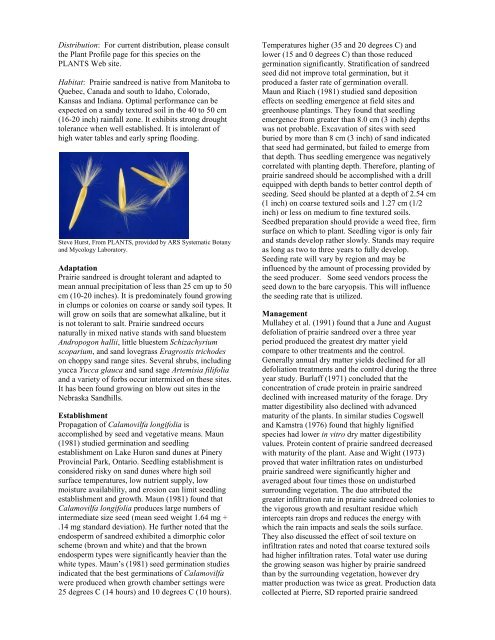Prairie Sandreed Plant Guide - Plant Materials Program
Prairie Sandreed Plant Guide - Plant Materials Program
Prairie Sandreed Plant Guide - Plant Materials Program
You also want an ePaper? Increase the reach of your titles
YUMPU automatically turns print PDFs into web optimized ePapers that Google loves.
Distribution: For current distribution, please consult<br />
the <strong>Plant</strong> Profile page for this species on the<br />
PLANTS Web site.<br />
Habitat: <strong>Prairie</strong> sandreed is native from Manitoba to<br />
Quebec, Canada and south to Idaho, Colorado,<br />
Kansas and Indiana. Optimal performance can be<br />
expected on a sandy textured soil in the 40 to 50 cm<br />
(16-20 inch) rainfall zone. It exhibits strong drought<br />
tolerance when well established. It is intolerant of<br />
high water tables and early spring flooding.<br />
Steve Hurst, From PLANTS, provided by ARS Systematic Botany<br />
and Mycology Laboratory.<br />
Adaptation<br />
<strong>Prairie</strong> sandreed is drought tolerant and adapted to<br />
mean annual precipitation of less than 25 cm up to 50<br />
cm (10-20 inches). It is predominately found growing<br />
in clumps or colonies on coarse or sandy soil types. It<br />
will grow on soils that are somewhat alkaline, but it<br />
is not tolerant to salt. <strong>Prairie</strong> sandreed occurs<br />
naturally in mixed native stands with sand bluestem<br />
Andropogon hallii, little bluestem Schizachyrium<br />
scoparium, and sand lovegrass Eragrostis trichodes<br />
on choppy sand range sites. Several shrubs, including<br />
yucca Yucca glauca and sand sage Artemisia filifolia<br />
and a variety of forbs occur intermixed on these sites.<br />
It has been found growing on blow out sites in the<br />
Nebraska Sandhills.<br />
Establishment<br />
Propagation of Calamovilfa longifolia is<br />
accomplished by seed and vegetative means. Maun<br />
(1981) studied germination and seedling<br />
establishment on Lake Huron sand dunes at Pinery<br />
Provincial Park, Ontario. Seedling establishment is<br />
considered risky on sand dunes where high soil<br />
surface temperatures, low nutrient supply, low<br />
moisture availability, and erosion can limit seedling<br />
establishment and growth. Maun (1981) found that<br />
Calamovilfa longifolia produces large numbers of<br />
intermediate size seed (mean seed weight 1.64 mg +<br />
.14 mg standard deviation). He further noted that the<br />
endosperm of sandreed exhibited a dimorphic color<br />
scheme (brown and white) and that the brown<br />
endosperm types were significantly heavier than the<br />
white types. Maun’s (1981) seed germination studies<br />
indicated that the best germinations of Calamovilfa<br />
were produced when growth chamber settings were<br />
25 degrees C (14 hours) and 10 degrees C (10 hours).<br />
Temperatures higher (35 and 20 degrees C) and<br />
lower (15 and 0 degrees C) than those reduced<br />
germination significantly. Stratification of sandreed<br />
seed did not improve total germination, but it<br />
produced a faster rate of germination overall.<br />
Maun and Riach (1981) studied sand deposition<br />
effects on seedling emergence at field sites and<br />
greenhouse plantings. They found that seedling<br />
emergence from greater than 8.0 cm (3 inch) depths<br />
was not probable. Excavation of sites with seed<br />
buried by more than 8 cm (3 inch) of sand indicated<br />
that seed had germinated, but failed to emerge from<br />
that depth. Thus seedling emergence was negatively<br />
correlated with planting depth. Therefore, planting of<br />
prairie sandreed should be accomplished with a drill<br />
equipped with depth bands to better control depth of<br />
seeding. Seed should be planted at a depth of 2.54 cm<br />
(1 inch) on coarse textured soils and 1.27 cm (1/2<br />
inch) or less on medium to fine textured soils.<br />
Seedbed preparation should provide a weed free, firm<br />
surface on which to plant. Seedling vigor is only fair<br />
and stands develop rather slowly. Stands may require<br />
as long as two to three years to fully develop.<br />
Seeding rate will vary by region and may be<br />
influenced by the amount of processing provided by<br />
the seed producer. Some seed vendors process the<br />
seed down to the bare caryopsis. This will influence<br />
the seeding rate that is utilized.<br />
Management<br />
Mullahey et al. (1991) found that a June and August<br />
defoliation of prairie sandreed over a three year<br />
period produced the greatest dry matter yield<br />
compare to other treatments and the control.<br />
Generally annual dry matter yields declined for all<br />
defoliation treatments and the control during the three<br />
year study. Burlaff (1971) concluded that the<br />
concentration of crude protein in prairie sandreed<br />
declined with increased maturity of the forage. Dry<br />
matter digestibility also declined with advanced<br />
maturity of the plants. In similar studies Cogswell<br />
and Kamstra (1976) found that highly lignified<br />
species had lower in vitro dry matter digestibility<br />
values. Protein content of prairie sandreed decreased<br />
with maturity of the plant. Aase and Wight (1973)<br />
proved that water infiltration rates on undisturbed<br />
prairie sandreed were significantly higher and<br />
averaged about four times those on undisturbed<br />
surrounding vegetation. The duo attributed the<br />
greater infiltration rate in prairie sandreed colonies to<br />
the vigorous growth and resultant residue which<br />
intercepts rain drops and reduces the energy with<br />
which the rain impacts and seals the soils surface.<br />
They also discussed the effect of soil texture on<br />
infiltration rates and noted that coarse textured soils<br />
had higher infiltration rates. Total water use during<br />
the growing season was higher by prairie sandreed<br />
than by the surrounding vegetation, however dry<br />
matter production was twice as great. Production data<br />
collected at Pierre, SD reported prairie sandreed
















